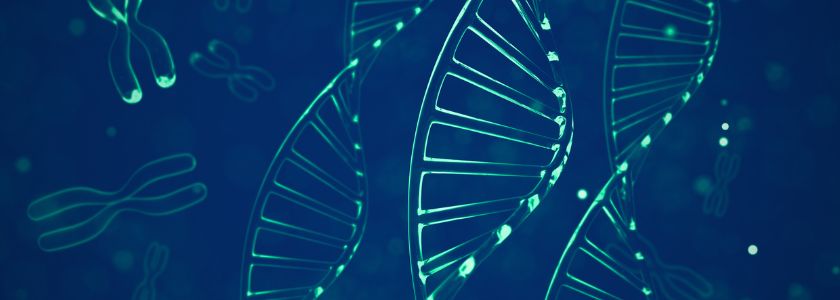How to use FISH (Fluorescence In Situ Hybridization) to find specific DNA sequences

The takeaway: What is fluorescence in situ hybridization? This technique, also called FISH, is used to detect and locate a specific DNA sequence.
When looking for a specific DNA sequence on a chromosome, researchers may want to turn to an effective technique called fluorescence in situ hybridization. This lab method takes a full set of chromosomes from an organism, places them on a glass slide, and then exposes them to a probe—a small piece of pure DNA labeled with a fluorescent dye. This probe locates and “fluorescently labels” its matching DNA sequence on the chromosome set.
What is fluorescence in situ hybridization?
Fluorescence in situ hybridization (FISH) is a method developed in the 1980s that uses a fluorescent dye to locate a specific DNA sequence in a chromosome.
How does fluorescent in situ hybridization work?
Fluorescent in situ hybridization works by using probes that can be designed for any sequence within a gene. These probes contain a fluorescent dye and are added to a cell or tissue sample. The probes look for their DNA matches in the chromosome and bind—when this happens, the fluorescence is activated and researchers, using a special light, can easily identify them.
What can fluorescent in situ hybridization detect?
The FISH technique can then be used to detect several things:
- Where a gene is located within a chromosome
- How many copies of a gene are present
- The presence of any chromosomal abnormalities
- In disease diagnosis
- In treatment planning
What applications is the FISH technique used for?
in situ hybridization is used to find specific features in DNA for use in species identification, medical research, and genetic counseling. It can also be used to detect and locate RNA targets in cells as well as circulating tumor cells and tissue samples, and it can be used as a way to define patterns of gene expression in cells and tissues.
What is a FISH probe?
A FISH probe is a small piece of DNA that has been purified and tagged with a fluorescent dye. Probes are strands that can be made up of DNA, RNA, or complementary DNA (cDNA). There are several types of probes for FISH, each with a different application. The different FISH probes include whole chromosome painting probes, repetitive sequence probes, and locus-specific probes. Repetitive sequence probes include telomeric probes and centromeric probes—the difference between the four is in the exact area where the fluorescence appears.
What is RNA FISH?
RNA FISH, or RNA fluorescent in situ hybridization, is a tool for seeing target messenger RNA transcripts in cells, tissue, or other circumstances. This type of FISH test permits the detection, localization, and quantification of single RNA molecules in pre-determined samples.
